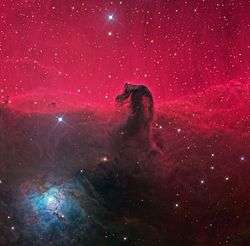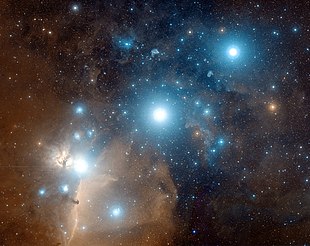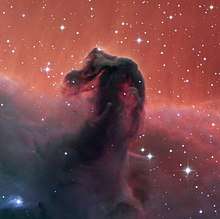Horsehead Nebula
The Horsehead Nebula (also known as Barnard 33) is a small dark nebula in the constellation Orion.[2] The nebula is located just to the south of Alnitak, the easternmost star of Orion's Belt, and is part of the much larger Orion Molecular Cloud Complex. It appears within the southern region of the dense dust cloud known as Lynds 1630, along the edge of the much larger, active star-forming H II region called IC 434.[3]
| Dark nebula | |
|---|---|
| diffuse | |
 The Horsehead Nebula. The reflection nebula NGC 2023 is in the bottom left corner and the nebula itself near the center, in the shape of the head of a horse. Photo taken in 2011. | |
| Observation data: J2000.0 epoch | |
| Right ascension | 05h 40m 59.0s |
| Declination | −02° 27′ 30.0" |
| Distance | 1375±54[1][note 1] ly (422±17[1] pc) |
| Apparent dimensions (V) | 8 × 6 arcmins |
| Constellation | Orion |
| Physical characteristics | |
| Radius | 3.5 ly |
| Designations | Barnard 33, LDN 1630 |
The Horsehead Nebula is approximately 422 parsecs or 1375 light years from Earth.[3][1] It is one of the most identifiable nebulae because of its resemblance to a horse's head.[4]
History
The nebula was first recorded in 1888 by Scottish astronomer Williamina Fleming on a photographic plate taken at the Harvard College Observatory.[5][6] One of the first descriptions was made by E.E. Barnard, describing it as: "Dark mass, diam. 4′, on nebulous strip extending south from ζ Orionis.", cataloguing the dark nebula as Barnard 33.[7]
Structure

The dark cloud of dust and gas is a region in the Orion Molecular Cloud Complex where star formation is taking place. It is located in the constellation of Orion, which is prominent in the winter evening sky in the Northern Hemisphere and the summer evening sky in the Southern Hemisphere.
Colour images reveal a deep-red colour that originates from ionised hydrogen gas (Hα) predominantly behind the nebula, and caused by the nearby bright star Sigma Orionis. Magnetic fields channel the gases, leaving the nebula into streams, shown as foreground streaks against the background glow.[8] A glowing strip of hydrogen gas marks the edge of the enormous cloud, and the densities of nearby stars are noticeably different on either side.
Heavy concentrations of dust in the Horsehead Nebula region and neighbouring Orion Nebula are localized into interstellar clouds, resulting in alternating sections of nearly complete opacity and transparency.[9] The darkness of the Horsehead is caused mostly by thick dust blocking the light of stars behind it.[10] The lower part of the Horsehead's neck casts a shadow to the left.[11] The visible dark nebula emerging from the gaseous complex is an active site of the formation of "low-mass" stars. Bright spots in the Horsehead Nebula's base are young stars just in the process of forming.
Image gallery
 Horse Head Nebula and Flame Nebula showing their surrounding nebulosity in Hydrogen alpha as seen in amateur telescopes.
Horse Head Nebula and Flame Nebula showing their surrounding nebulosity in Hydrogen alpha as seen in amateur telescopes. Horsehead and flame Nebulae 384mm scope Ha-RGB imaged with amateur equipment.
Horsehead and flame Nebulae 384mm scope Ha-RGB imaged with amateur equipment. Interstellar dust of the Horsehead Nebula as revealed by the Hubble Space Telescope.
Interstellar dust of the Horsehead Nebula as revealed by the Hubble Space Telescope. The Horsehead Nebula seen by SPECULOOS's Callisto telescope
The Horsehead Nebula seen by SPECULOOS's Callisto telescope
Notes
- Based on the parallax of 2MASS J05405172-0226489, a young stellar object embedded in the 'head' of the nebula.
References
- Brown, A. G. A.; et al. (Gaia collaboration) (August 2018). "Gaia Data Release 2: Summary of the contents and survey properties". Astronomy & Astrophysics. 616. A1. arXiv:1804.09365. Bibcode:2018A&A...616A...1G. doi:10.1051/0004-6361/201833051.
- Arnett, Bill (2000). "Horsehead Nebula". Retrieved July 21, 2014.
- "VLT Images the Horsehead Nebula". European Southern Observatory. European Southern Observatory. 25 January 2002. Retrieved 1 March 2019.
- Sharp, Nigel (2014). "The Horsehead Nebula". National Optical Astronomy Observatory. Association of Universities for Research in Astronomy. Retrieved July 21, 2014.
- Alex Newman (28 August 2017). "Unearthing the legacy of Harvard's female 'computers'". BBC News. Retrieved 28 August 2017.
- Cannon, Annie J. (June 1911). "Williamina Paton Fleming". Science (published June 30, 1911). 33 (861): 987–988. Bibcode:1911Sci....33..987C. doi:10.1126/science.33.861.987. PMID 17799863.
- Barnard, E. E. (1919). "On the dark markings of the sky, with a catalogue of 182 such objects". Astrophysical Journal. 49: 1–24. Bibcode:1919ApJ....49....1B. doi:10.1086/142439.
- "The Horsehead Nebula/IC434". National Optical Astronomy Observatory. NOAO. Retrieved 12 May 2014.
- Morgan, W.W.; Lodén, Kerstin (1966). "Some Characteristics of the Orion Association". Vistas in Astronomy. 8 (1): 83–88. Bibcode:1966VA......8...83M. doi:10.1016/0083-6656(66)90023-7. ISSN 0083-6656.
- Mayo Greenberg, J (2002). "Cosmic dust and our origins". Surface Science. 500 (1–3): 793–822. Bibcode:2002SurSc.500..793M. doi:10.1016/S0039-6028(01)01555-2. ISSN 0039-6028.
- Nemiroff, R.; Bonnell, J., eds. (21 July 2009). "The Horsehead Nebula". Astronomy Picture of the Day. NASA. Retrieved 12 May 2014.
External links
| Wikimedia Commons has media related to Horsehead Nebula. |
- SOFIA/upGREAT [C II] Velocity Resolved Map of the Horsehead Nebula
- The Horsehead Nebula @ The Electronic Sky
- Hubble Observes the Horsehead Nebula
- The discovery of early photographs of the Horsehead nebula, by Waldee and Hazen
- The Horsehead Nebula in the 19th Century, by Waldee
- Detection of new nebulae by photography, by Pickering
- Horsehead Nebula at ESA/Hubble
- The Horsehead Nebula at the Astro-Photography site of Mr. T. Yoshida.
- The Horsehead-Nebula and neighboring structures in a classical view
- The Horsehead Nebula on interactive astro-photography survey at Wikisky.org
- The Horsehead Nebula at Constellation Guide